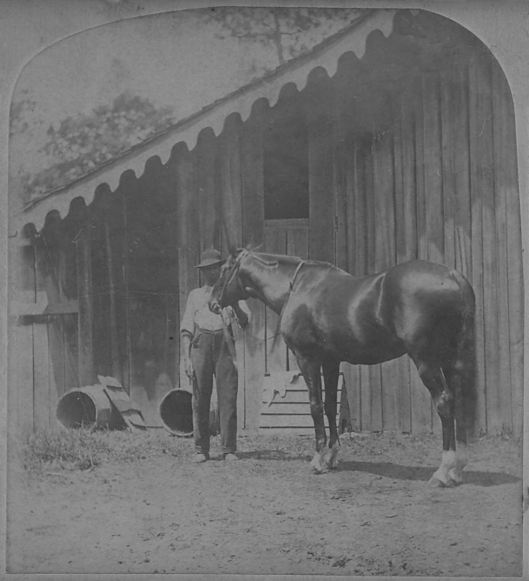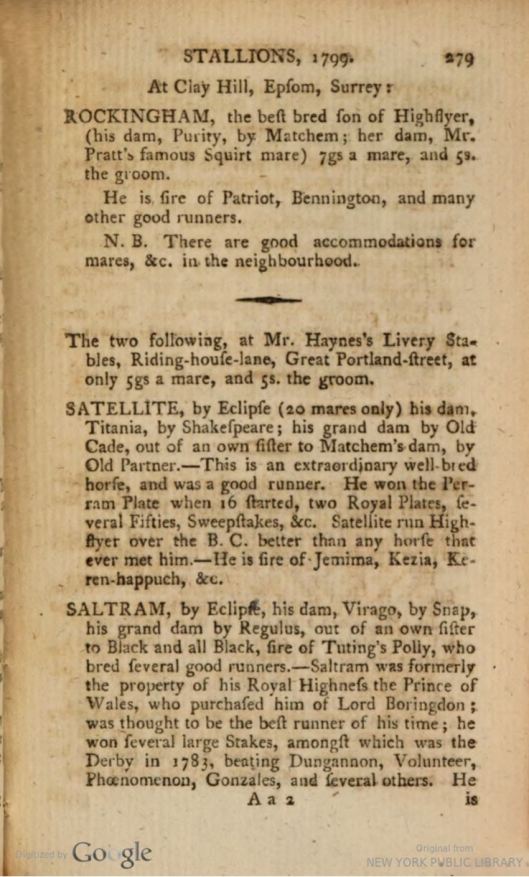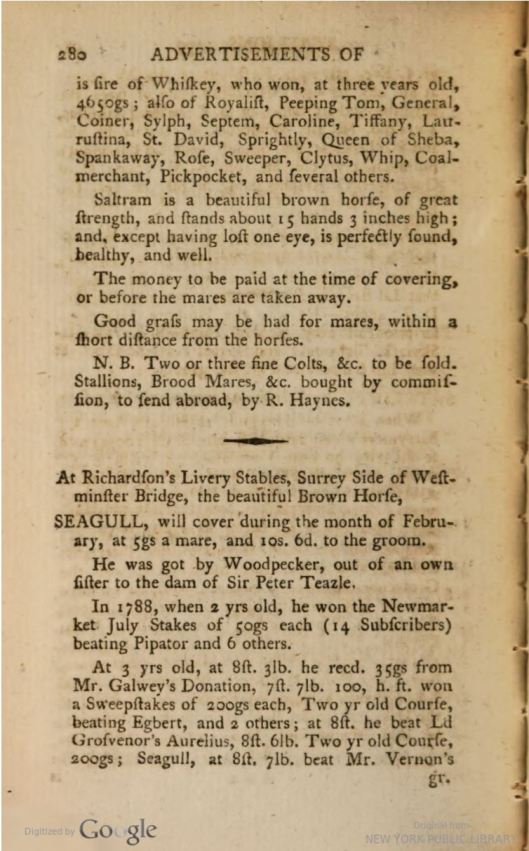In a comment to my post earlier this week about the Jersey Act, EJC Blackwood elaborated on the problem with Lexington’s pedigree: the 1783 Derby Stakes winner Saltram. The horse appears twice in the pedigree of Lexington; the first was through his grandsire Timoleon, who is out of a mare by Saltram that is stated to have been bred in the U.S., and the second appearance of Saltram was as great-grandsire of Lexington’s third dam (by U.S.-bred Robin Grey, by English-bred Royalist, by Saltram).

Lexington – the son of Boston was the greatest American stallion of the 19th century and became omnipresent in American bloodlines. He was the primary “offender” from the perspective of British authorities due to the questioned presence of the English stallion Saltram in his pedigree.
Royalist seems to be universally admitted as having been imported to the States and used as a stallion here. Not so with Saltram.
From what I’ve learned from Edward Blackwood and some early-morning researches, Saltram was the crux to the pedigree problem with Timoleon and his exceptional descendant Lexington.
From the references to pedigree problems or anomalies that influenced British authorities to question the authenticity of American pedigrees, it was clear that Lexington was the particular fly in the ointment that made English breeders and registration authorities so suspicious about “American blood.”
None of the sources that I had read previous to the discussion with EJC Blackwood, however, had mentioned that the fault with Timoleon was his maternal grandsire Saltram. The specific problem is that some authorities believe the horse was not sent to the States. That does pose a problem.
Some sources do list Saltram as an import of 1799, coming to Virginia for William Lightfoot. Verification of this kind of thing is triply difficult because 1) there was no log of exportations from England, 2) there was no official record of importations to the U.S., and 3) there was no operating stud book in the States at the time. The latter was officially created in 1867 through the publication of the American Stud Book Volume 1 from Sanders Bruce and B.G. Bruce, although there had been published records of pedigrees and blooded horses quite a bit prior to that date.

Among the records available to me, the English Racing Calendar of 1798 lists Saltram as being at stud for 1799. In England.

It is possible that he stood the 1799 season at the stable in England, then was exported in the summer or fall of 1799 to America. In fact, in the American Stud Book of 1867, Volume 1, the Bruces list Saltram as being imported by William Lightfoot but without a date of import. That was two-thirds of a century after the horse’s reported relocation, and if it is taken as the authoritative document for Saltram’s importation, it does leave a little to doubt.
But there is an earlier reference. In the American Race-Turf Register and General Stud Book of 1833, Patrick Nisbett Edgar places Saltram as an import to Virginia by Lightfoot and gives the date as 1800. That is a more solid reference, given that the horse would have been verifiable in the memory of living men, and physical records should still have existed to show transactions related to his importation and even to his book of mares bred.
If they existed, they have not come to my attention, and presumably there was further contention about the matter for it to have been an issue more than a century later when it posed a problem for the General Stud Book authorities in England.
Furthermore, one of EJC Blackwood’s sources from Russia believes the horse was sent there and “buried by the banks of the Volga.”
Clearly, this relatively minor stallion cannot have been in three places at once, nor have sired foals in multiple hemispheres simultaneously. So the problem of time and space reveals itself, and the exact provenance of Lexington’s and Timoleum’s pedigrees remains obscure.

A similar anomaly exists regarding Janus (aka Little Janus, aka Stiff Dick), by Janus (aka Old Janus), by the Godolphin Arabian. He was supposedly sent to the US in 1756, where he is credited with being a major influence in the development of the Quarter Horse. Apparently he is also advertised as covering in England at a later date.
Wow! The mystery deepens. Well whoever sired this line, thank you for Lexington.
A very nice coverage of the story Frank., thank you..
The record of Lexingtons get provides him a pedigree as good as Britains best.
This is quite the mystery but we cannot argue with success. Lexington is still Lexington. Thanks for a fascinating study on this. I looked at all the pedigrees.
This could go on I imagine and will continue to be most interesting. For everyone,
look at the pedigrees. Thanks Frank.
Great writing and research, Frank! Glad that you are doing what you do!
Thank you, Lucy! I am so pleased to be able to read, write, and research such fascinating things as Thoroughbred history and bloodlines. How are things with you?